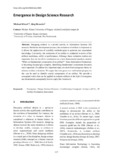Zitierlink:
http://dx.doi.org/10.25819/ubsi/2805Dateien zu dieser Ressource:
| Datei | Beschreibung | Größe | Format | |
|---|---|---|---|---|
| Emergence_in_Design_Science_Research.pdf | 256.61 kB | Adobe PDF |  Öffnen/Anzeigen |
| Dokumentart: | InProceedings | Titel: | Emergence in design science research | AutorInn(en): | Klesel, Michael Henseler, Jörg |
Institut: | Forschungskolleg “Institute for Advanced Study” (FoKos) | Schlagwörter: | Emergence, Design Science Research, Confirmatory Composite Analysis (CCA), IT Artifact Evaluation, Innovation, Designwissenschaftliche Forschung, Innovation, Bestätigende Verbundanalyse (CCA), Bewertung von IT-Artefakten | DDC-Sachgruppe: | 004 Informatik | GHBS-Notation: | QGT | Erscheinungsjahr: | 2020 | Publikationsjahr: | 2020 | Auch erschienen: | Radtke, Jörg (Hrsg.) ; Klesel, Michael (Hrsg.) ; Niehaves, Björn (Hrsg.): New perspectives on digitalization: Local issues and global impact. Siegen: Universitätsbibliothek Siegen, 2020. - DOI http://dx.doi.org/10.25819/ubsi/1894, S. 117 - 125 | Zusammenfassung: | Designing artifacts is a pivotal activity in Information Systems (IS) research. Beside the development process, the evaluation of artifacts is important as it allows the application of scientific methodologies to generate and accumulate knowledge. Commonly, the evaluation of an artifact is conducted in terms of the artifacts usefulness, utility or performance. Although those evaluation metrics are important, they do not allow conclusions on a more fundamental question, namely “What are fundamental components of an artifact?”. Since Information Technology is becoming increasingly complex, identifying fundamental components becomes more important. To address this important topic, we draw from emergence theory to enhance artifact evaluation. We argue that emergence is a well-suited perspective that can be used to identify crucial components of an artifact. We provide a conceptual notion that can be applied to evaluate artifacts in the light of emergence and demonstrate conceptually how to apply this framework. |
DOI: | http://dx.doi.org/10.25819/ubsi/2805 | URN: | urn:nbn:de:hbz:467-16366 | URI: | https://dspace.ub.uni-siegen.de/handle/ubsi/1636 | Lizenz: | http://creativecommons.org/licenses/by-nc-nd/4.0/ |
| Enthalten in den Sammlungen: | Publikationen aus der Universität Siegen |
Diese Ressource ist urheberrechtlich geschützt. |
Seitenansichten
945
checked on 10.01.2025
Download(s)
474
checked on 10.01.2025
Google ScholarTM
Prüfe
Prüfe
Diese Ressource wurde unter folgender Copyright-Bestimmung veröffentlicht: Lizenz von Creative Commons


